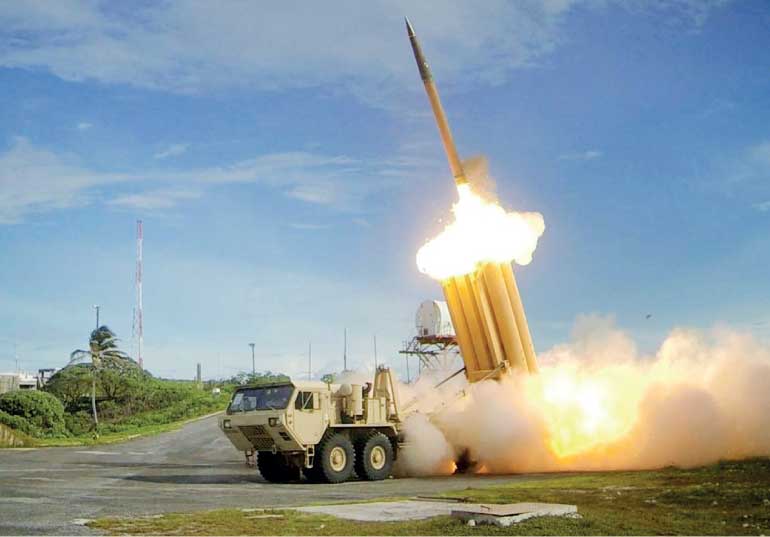Wednesday Mar 05, 2025
Wednesday Mar 05, 2025
Monday, 4 December 2017 00:00 - - {{hitsCtrl.values.hits}}

A Terminal High Altitude Area Defence (THAAD) interceptor is launched during a successful intercept test, in this undated handout photo provided by the US Department of Defence, Missile Defence Agency
Simi Valley, Calif (Reuters): The U.S. agency tasked with protecting the country from missile attacks is scouting the West Coast for places to deploy new anti-missile defences, two Congressmen said on Saturday, as North Korea’s missile tests raise concerns about how the United States would defend itself from an attack.
West Coast defences would likely include Terminal High Altitude Area Defence (THAAD) anti-ballistic missiles, similar to those deployed in South Korea to protect against a potential North Korean attack.
The accelerated pace of North Korea’s ballistic missile testing program in 2017 and the likelihood the North Korean military could hit the U.S. mainland with a nuclear payload in the next few years has raised the pressure on the United States government to build-up missile defences.
On Wednesday, North Korea tested a new type of intercontinental ballistic missile (ICBM) that can fly over 13,000 km (8,080 miles), placing Washington within target range, South Korea said on Friday.
Congressman Mike Rogers, who sits on the House Armed Services Committee and chairs the Strategic Forces Subcommittee which oversees missile defence, said the Missile Defence Agency (MDA), was aiming to install extra defences at West Coast sites. The funding for the system does not appear in the 2018 defence budget plan indicating potential deployment is further off.
“It’s just a matter of the location, and the MDA making a recommendation as to which site meets their criteria for location, but also the environmental impact,” the Alabama Congressman and Republican told Reuters during an interview on the sidelines of the annual Reagan National Defence Forum in southern California.
When asked about the plan, MDA Deputy Director Rear Admiral Jon Hill said in a statement: “The Missile Defence Agency has received no tasking to site the Terminal High Altitude Air Defence System on the West Coast.”
The MDA is a unit of the U.S. Defence Department.
Congressman Rogers did not reveal the exact locations the agency is considering but said several sites are “competing” for the missile defence installations.
Rogers and Congressman Adam Smith, a Democrat representing the 9th District of Washington, said the government was considering installing the THAAD anti-missile system made by aerospace giant Lockheed Martin Corp, at west coast sites.
The Congressmen said the number of sites that may ultimately be deployed had yet to be determined.
THAAD is a ground-based regional missile defence system designed to shoot down short-, medium- and intermediate-range ballistic missiles and takes only a matter of weeks to install.
In addition to the two THAAD systems deployed in South Korea and Guam in the Pacific, the U.S. has seven other THAAD systems. While some of the existing missiles are based in Fort Bliss, Texas, the system is highly mobile and current locations are not disclosed.
A Lockheed Martin representative declined to comment on specific THAAD deployments, but added that the company “is ready to support the Missile Defence Agency and the United States government in their ballistic missile defence efforts.” He added that testing and deployment of assets is a government decision.
In July, the United States tested THAAD missile defences and shot down a simulated, incoming intermediate-range ballistic missile (IRBM). The successful test adds to the credibility of the U.S. military’s missile defence program, which has come under intense scrutiny in recent years due in part to test delays and failures.
Currently, the continental United States is primarily shielded by the Ground-based Midcourse Defence system (GMD) in Alaska and California as well as the Aegis system deployed aboard U.S. Navy ships. The THAAD system has a far higher testing success rate than the GMD.
The MDA told Congress in June that it planned to deliver 52 more THAAD interceptors to the U.S. Army between October 2017 and September 2018, bringing total deliveries to 210 since May 2011.
North Korea’s latest missile test puts the U.S. capital within range, but Pyongyang still needs to prove it has mastered critical missile technology, such as re-entry, terminal stage guidance and warhead activation, South Korea said on Friday.
Discover Kapruka, the leading online shopping platform in Sri Lanka, where you can conveniently send Gifts and Flowers to your loved ones for any event including Valentine ’s Day. Explore a wide range of popular Shopping Categories on Kapruka, including Toys, Groceries, Electronics, Birthday Cakes, Fruits, Chocolates, Flower Bouquets, Clothing, Watches, Lingerie, Gift Sets and Jewellery. Also if you’re interested in selling with Kapruka, Partner Central by Kapruka is the best solution to start with. Moreover, through Kapruka Global Shop, you can also enjoy the convenience of purchasing products from renowned platforms like Amazon and eBay and have them delivered to Sri Lanka.
Discover Kapruka, the leading online shopping platform in Sri Lanka, where you can conveniently send Gifts and Flowers to your loved ones for any event including Valentine ’s Day. Explore a wide range of popular Shopping Categories on Kapruka, including Toys, Groceries, Electronics, Birthday Cakes, Fruits, Chocolates, Flower Bouquets, Clothing, Watches, Lingerie, Gift Sets and Jewellery. Also if you’re interested in selling with Kapruka, Partner Central by Kapruka is the best solution to start with. Moreover, through Kapruka Global Shop, you can also enjoy the convenience of purchasing products from renowned platforms like Amazon and eBay and have them delivered to Sri Lanka.